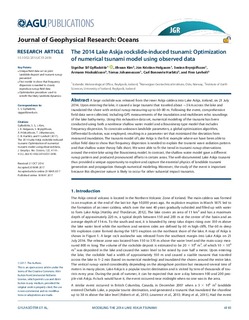| dc.contributor.author | Gylfadottir, Sigridur Sif | |
| dc.contributor.author | Kim, Jihwan | |
| dc.contributor.author | Helgason, Jon Kristinn | |
| dc.contributor.author | Brynjólfsson, Sveinn | |
| dc.contributor.author | Höskuldsson, Ármann | |
| dc.contributor.author | Jóhannesson, Tómas | |
| dc.contributor.author | Harbitz, Carl Bonnevie | |
| dc.contributor.author | Løvholt, Finn | |
| dc.date.accessioned | 2018-11-22T09:18:43Z | |
| dc.date.available | 2018-11-22T09:18:43Z | |
| dc.date.created | 2017-07-20T09:40:19Z | |
| dc.date.issued | 2017 | |
| dc.identifier.citation | Journal of Geophysical Research - Oceans. 2017, 122 (5), 4110-4122. | |
| dc.identifier.issn | 2169-9275 | |
| dc.identifier.uri | http://hdl.handle.net/11250/2574262 | |
| dc.description.abstract | A large rockslide was released from the inner Askja caldera into Lake Askja, Iceland, on 21 July 2014. Upon entering the lake, it caused a large tsunami that traveled about ∼3 km across the lake and inundated the shore with vertical runup measuring up to 60–80 m. Following the event, comprehensive field data were collected, including GPS measurements of the inundation and multibeam echo soundings of the lake bathymetry. Using this exhaustive data set, numerical modeling of the tsunami has been conducted using both a nonlinear shallow water model and a Boussinesq-type model that includes frequency dispersion. To constrain unknown landslide parameters, a global optimization algorithm, Differential Evolution, was employed, resulting in a parameter set that minimized the deviation from measured inundation. The tsunami model of Lake Askja is the first example where we have been able to utilize field data to show that frequency dispersion is needed to explain the tsunami wave radiation pattern and that shallow water theory falls short. We were able to fit the trend in tsunami runup observations around the entire lake using the Boussinesq model. In contrast, the shallow water model gave a different runup pattern and produced pronounced offsets in certain areas. The well-documented Lake Askja tsunami thus provided a unique opportunity to explore and capture the essential physics of landslide tsunami generation and propagation through numerical modeling. Moreover, the study of the event is important because this dispersive nature is likely to occur for other subaerial impact tsunamis. | |
| dc.description.abstract | The 2014 Lake Askja rockslide-induced tsunami: Optimization of numerical tsunami model using observed data | |
| dc.language.iso | eng | |
| dc.title | The 2014 Lake Askja rockslide-induced tsunami: Optimization of numerical tsunami model using observed data | |
| dc.title.alternative | The 2014 Lake Askja rockslide-induced tsunami: Optimization of numerical tsunami model using observed data | |
| dc.type | Peer reviewed | |
| dc.type | Journal article | |
| dc.description.version | publishedVersion | |
| dc.source.pagenumber | 4110-4122 | |
| dc.source.volume | 122 | |
| dc.source.journal | Journal of Geophysical Research - Oceans | |
| dc.source.issue | 5 | |
| dc.identifier.doi | 10.1002/2016JC012496 | |
| dc.identifier.cristin | 1482651 | |
| dc.relation.project | Norges forskningsråd: 231252 | |
| cristin.unitcode | 7452,4,2,0 | |
| cristin.unitcode | 7452,3,3,0 | |
| cristin.unitname | Computational Geomechanics (CGM) | |
| cristin.unitname | Risiko, Skredgeoteknikk og Klimatilpasning | |
| cristin.ispublished | true | |
| cristin.fulltext | original | |
| cristin.qualitycode | 2 | |
